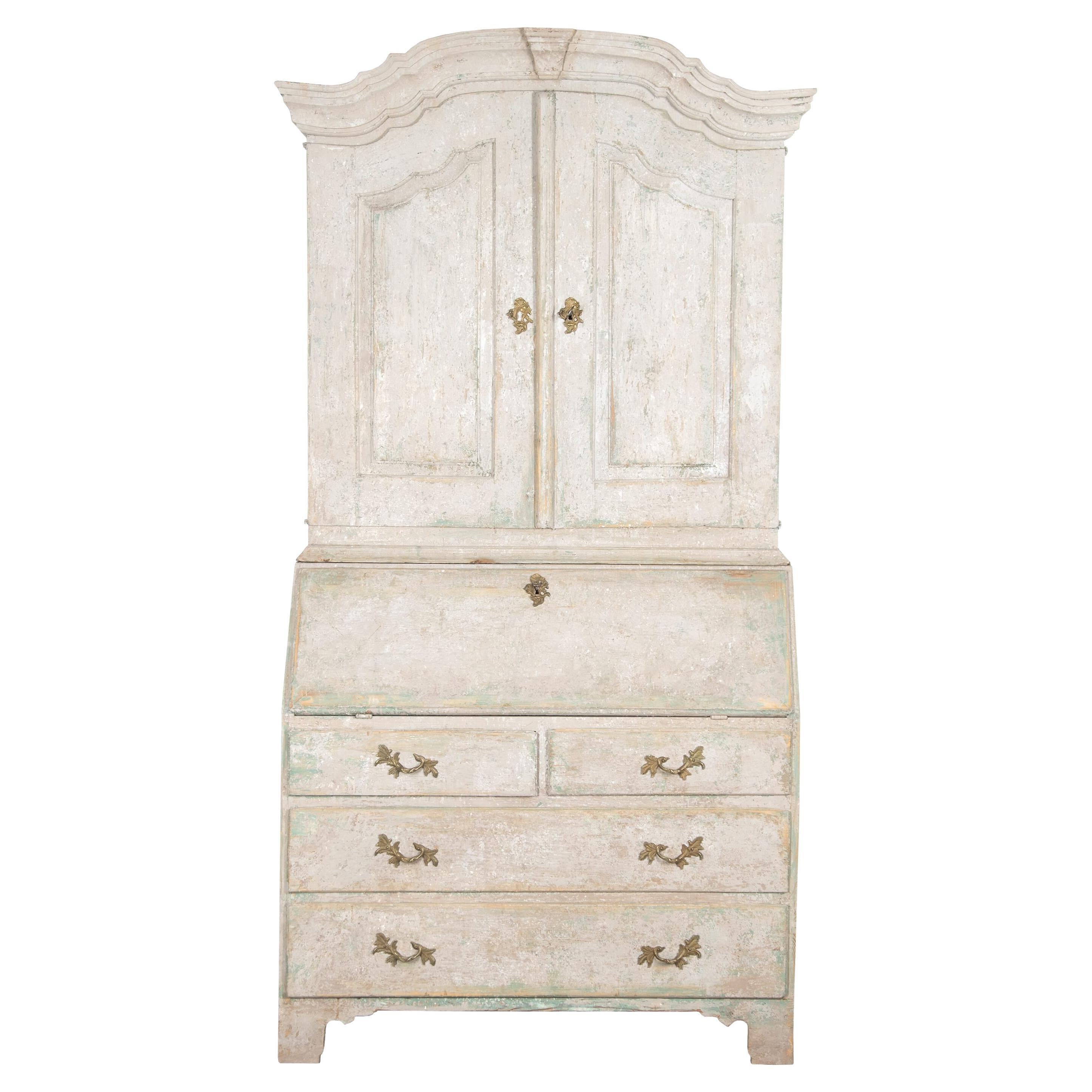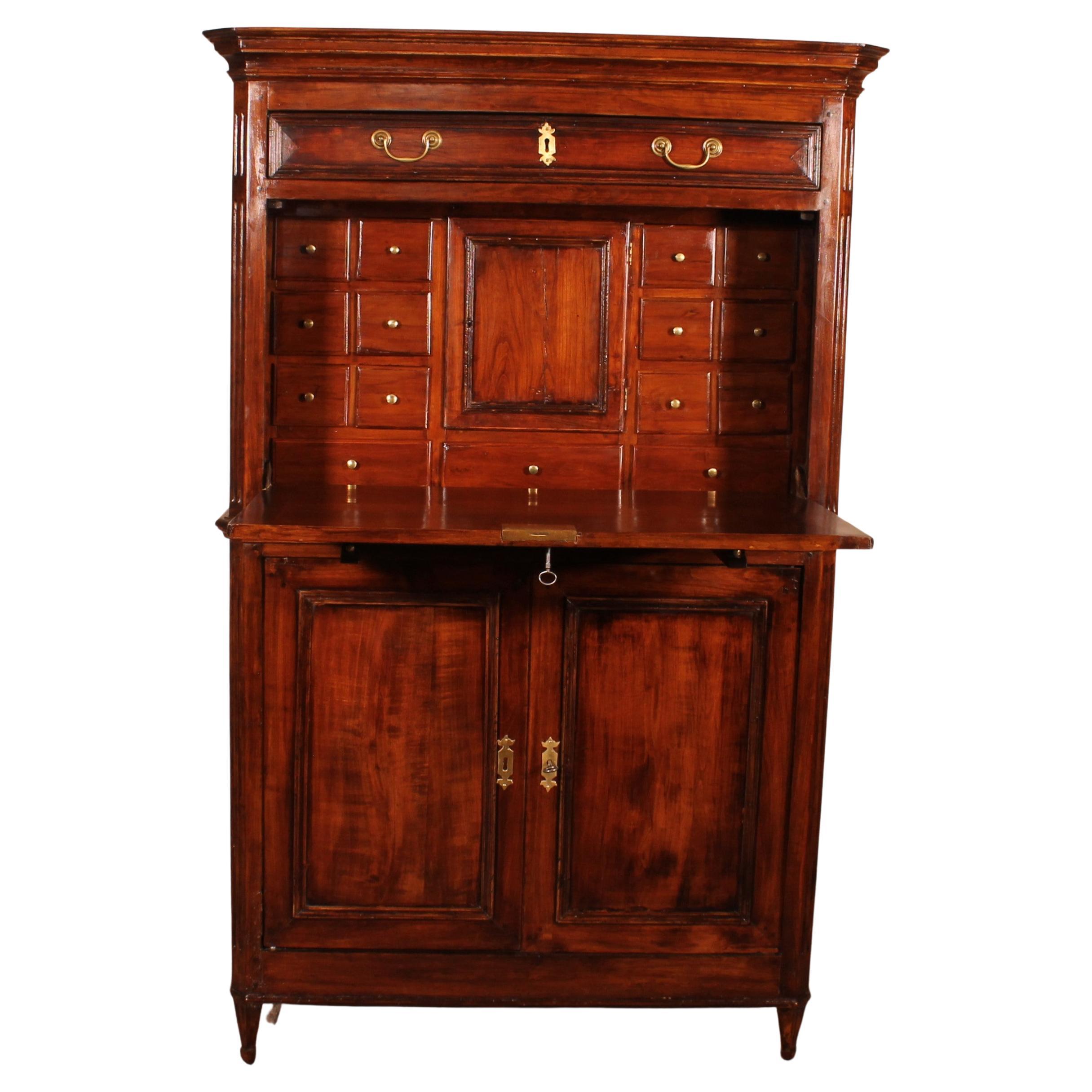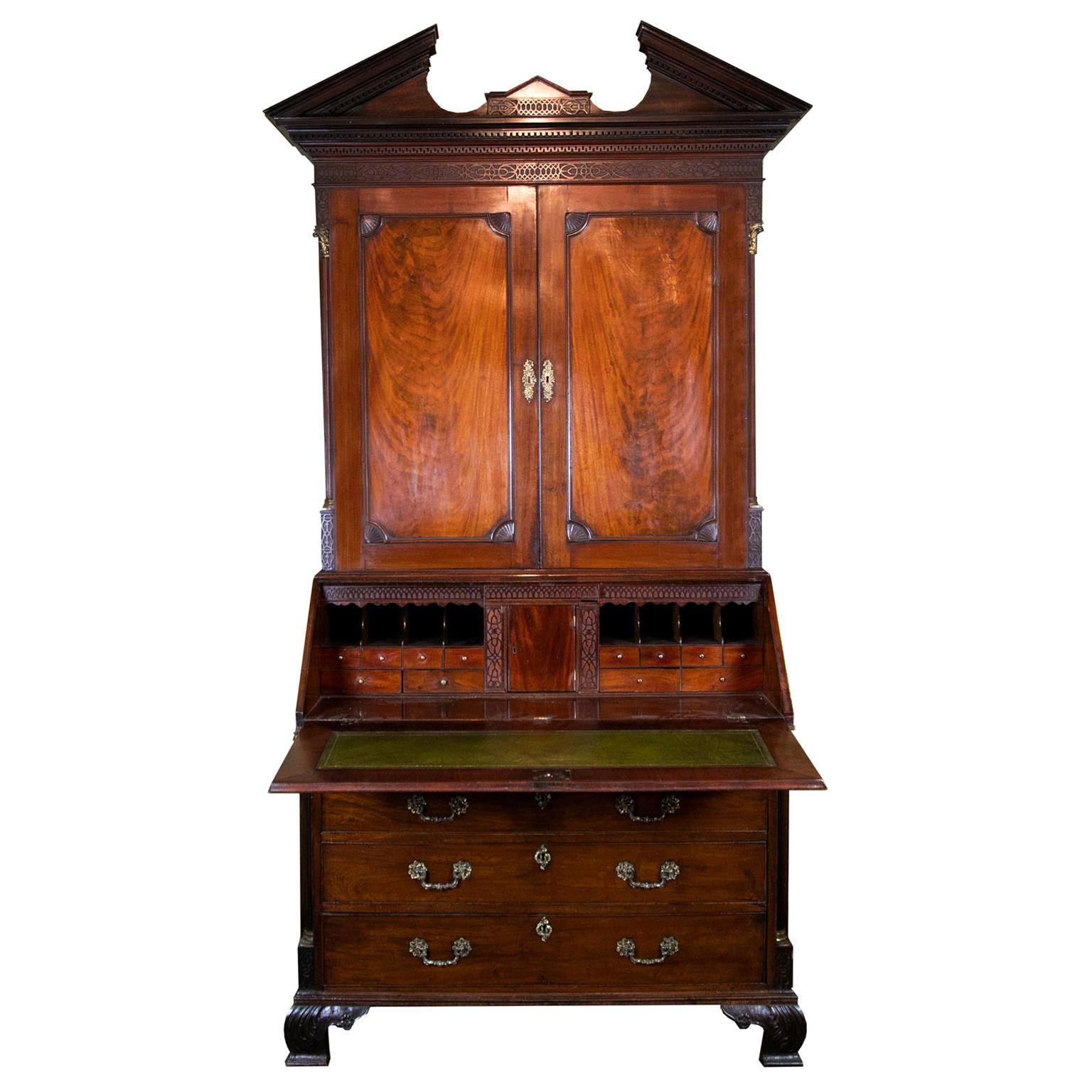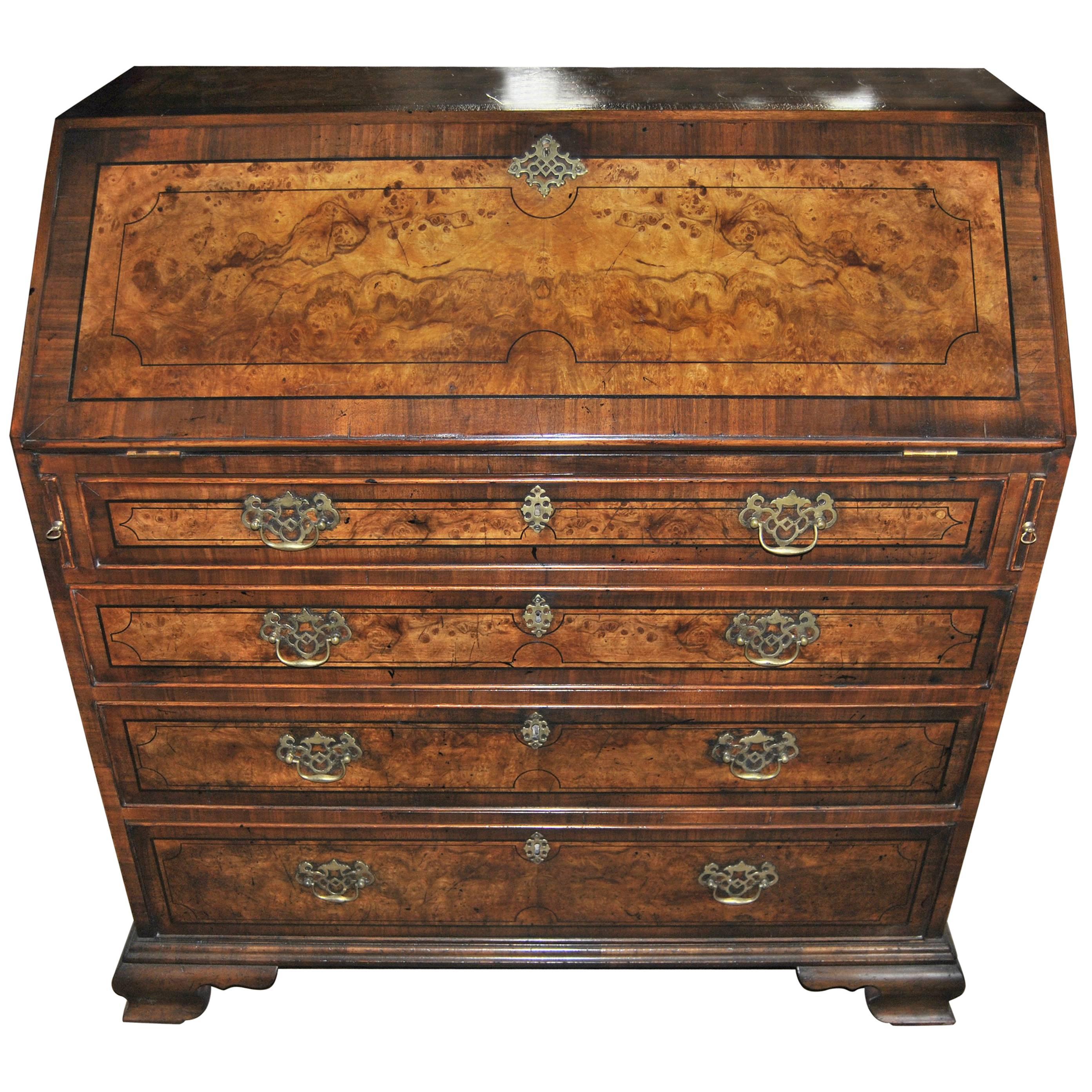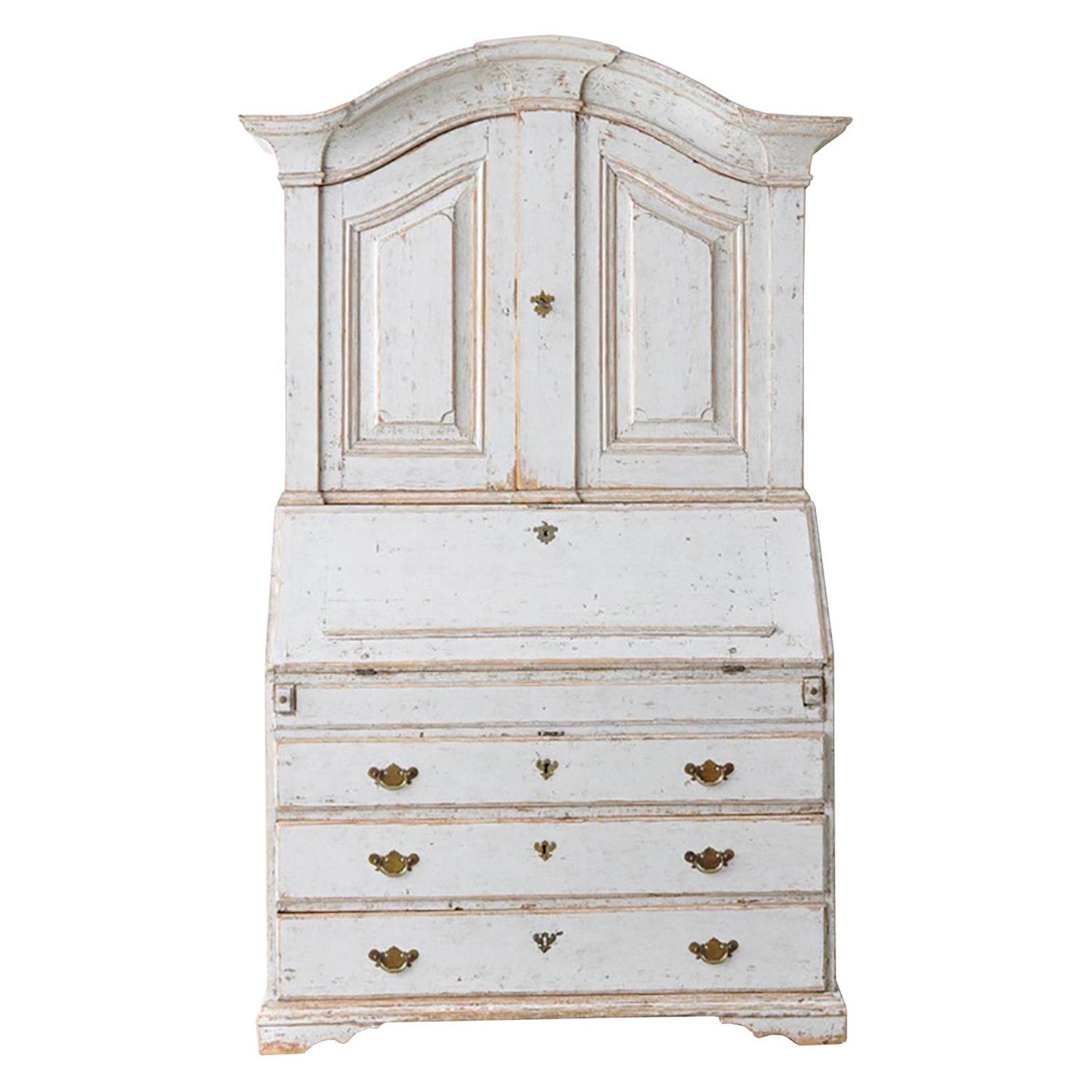Items Similar to 18th Century English Secretary
Want more images or videos?
Request additional images or videos from the seller
1 of 6
18th Century English Secretary
About the Item
Queen Anne period furnishings such as this walnut secretary are incredibly rare and important examples of English cabinetmaking. This secretary is of the most outstanding caliber, boasting desirable double bonnet, mirrored cabinet doors and later bun feet and its original embossed leather writing surface. The interior is skillfully constructed with a choice of compartments in which to hide one's important documents and valuables. A secret drawer is also concealed in the side of the bureau interior. Remove the bottom left hand drawer and pull on the oak fillet tucked flush with the side. The expert craftsmanship of such a complicated item required the skill and attention of the finest cabinetmakers, to which its high level of quality can attest. The inclusion of original brass locks and some pulls adds to this secretary's desirability,
circa 1720.
Measures:
36 1/2" wide x 24" deep x 79" high.
- Dimensions:Height: 79 in (200.66 cm)Width: 36.5 in (92.71 cm)Depth: 24 in (60.96 cm)
- Style:Queen Anne (Of the Period)
- Materials and Techniques:
- Place of Origin:
- Period:
- Date of Manufacture:circa 1720
- Condition:
- Seller Location:New Orleans, LA
- Reference Number:
About the Seller
5.0
Recognized Seller
These prestigious sellers are industry leaders and represent the highest echelon for item quality and design.
Established in 1912
1stDibs seller since 2010
93 sales on 1stDibs
Typical response time: 7 hours
- ShippingRetrieving quote...Ships From: New Orleans, LA
- Return PolicyThis item cannot be returned.
More From This SellerView All
- 19th Century French Secrétaire by DurandBy Gervais DurandLocated in New Orleans, LASuperior craftsmanship and intricate marquetry characterize this rare secrétaire by Gervais-Maximilien-Eugène Durand, one of the most popular French ébénistes of the 19th century. Th...Category
Antique 19th Century French Louis XV Secretaires
MaterialsBronze, Ormolu
- King George I Ambassadorial Secrétaire-CabinetLocated in New Orleans, LAThis highly important secrétaire-cabinet was crafted for and specially ordered by King George I for the British Ambassador to Russia. From its craftsmanship and materials to its exceptional artistry, it is a work of royal and historic significance that exudes power in each and every detail. The broken pediment at its apex features the simplified royal coat of arms bearing the king’s crown, while the interior is adorned by portraits of the British Royal Family. Placed within the ambassador’s St. Petersburg home, this entirely unique piece of furniture would have been a potent reminder of England's grandeur and political importance. Relations between England and Russia during this period were at an all-time high. Peter the Great had traveled to England in 1698 as part of his widely known “Grand Embassy” tour, wherein he attempted to gain foreign support against the Ottoman Empire. He spent a period of nearly four months there, meeting with King William III and his court on numerous occasions. Noted academic Arthur MacGregor wrote concerning the impact of the trip, “For two decades following Peter's visit, British influence in Russia reached a peak. It manifested itself in social custom, in craft practice and in ships and naval organization... it reached a significant sector of the population before relations cooled once again and the two nations pulled back from this era of unprecedented cordiality.” First and foremost, however, it is a reminder of British might and influence. By the reign of King George I, England had come into its own as a world power. Unique in its design, this cabinet is a reflection of the country’s might. It is crafted from the highest-quality solid walnut and burr walnut adorned by gilded lock plates and engraved hinges. The presence of ormolu at its apex and lining the doors was a rarity for this period, and its addition makes manifest the importance of the design. The outer doors open to reveal multiple interiors, including fifteen separate drawers around a central cupboard; the cupboard doors each bear mezzotint portraits of George I and his father, Ernest Augustus, Elector of Hanover. An etching after the portrait of George I dating to circa 1716 is in London’s Royal Academy. A second, inner pair of doors are adorned by mezzotints of the Prince and Princess of Wales (later Queen Caroline and George II), which are both after portraits by Sir Godfrey Kneller dated 1716 in the Royal Collection. A final portrait is revealed on the very interior of the cabinet, where a mezzotint of Frederick, Anne, Amelia and Caroline, children of the Prince of Wales, resides. An etching (circa 1715-1720) after this portrait can be found in the National Portrait Gallery (London). Apart from its abundance of royal portraiture, the cabinet features stunning painted decoration, including floral designs as well as clouds, birds and trees in a bucolic motif reminiscent of Eden. Its lower portion is a study in both form and function, featuring a fitted secrétaire-drawer above three additional drawers for storage. The cabinet appears in The Shorter Dictionary of English Furniture by R. Edwards from 1964, a text that is regarded as the bible of British furniture design. Edwards describes it as a “writing cabinet...given by George I to the British Ambassador at the Russian court.” The cabinet was likely made for the 18th-century German diplomat and writer Friedrich Christian Weber, who represented English interests at the Russian court from 1714 until 1719. Although Weber’s tenure as ambassador was relatively short, while in St. Petersburg, he authored his account entitled Das veraenderte Russland (The Present State of Russia), which was published in three volumes in 1721, 1739 and 1740. It may, however, also have been made for George Douglas, 2nd Earl of Dumbarton, who served as ambassador alongside Weber in 1716. Diplomatic relations ceased between the two countries in 1721. In 1928, the cabinet appeared for sale at the International Exhibition of Antiques & Works of Art in Olympia. It had previously been in the collection of the Woltner family of Bordeaux, the celebrated vintners who owned the estate Château Laville Haut-Brion and produced wine of the same name. According to the family, Monsieur Woltner was given the cabinet as a gift from an aunt who lived in Russia for many years. After leaving the Woltner collection, the cabinet was acquired by William Berry...Category
Antique 18th Century English Georgian Secretaires
MaterialsBrass
- 18th Century English Agate Snuff BoxLocated in New Orleans, LATrimmed in elegant yellow gold is this polished English agate snuff box. Distinguished by the dynamic patterning of the agate, the exquisite vessel i...Category
Antique 18th Century English Other Snuff Boxes and Tobacco Boxes
MaterialsAgate, Gold
- 19th Century Dutch Bureau BookcaseLocated in New Orleans, LAThis magnificent and important Dutch mahogany bureau bookcase, exuberantly carved and adorned with superb figural carvings, impressive scrolled feet and elaborate applied decoration....Category
Antique 19th Century Dutch Other Bookcases
MaterialsMahogany
- 19th Century Coromandel Inlaid VitrineLocated in New Orleans, LAHighly-prized coromandel, or East Indian ebony, was used to create this beautiful Victorian vitrine. Featuring delicate inlay in the Victorian/Edwardian style and glass panels framed in the equally luxurious satinwood, this cabinet is constructed to fit flush against a wall with baseboards. Elegant cabinets such as this are perfect for displaying one's treasures, but with original locks, keys, mirrors and fleur-de-lis fabric, this case is a prized possession unto itself, circa 1890. Measures: 30" wide x 14 ½" deep x 41 ½" high. Coromandel ebony is variegated brown and black, often called "streaky," wood. It is considered a highly valuable wood for turnery, fine cabinet...Category
Antique 19th Century English Victorian Vitrines
MaterialsGlass, Mirror, Ebony, Satinwood
- 19th Century Watch Winding Display CabinetLocated in New Orleans, LAThis incredible, one-of-a-kind watch display cabinet brings together the beauty of an antique with the functionality of modern technology. Crafted of mahogany, this 19th century jewelry display cabinet...Category
Antique 19th Century Unknown Empire Cabinets
MaterialsMahogany
You May Also Like
- Swedish 18th Century Rococo SecretaryLocated in Tetbury, Gloucestershire18th century Rococo cabinet. With a decorative carved pediment and two doors opening to storage. Below sits a fall front desk, opening to useful writing or computer space. With two further small storage drawers...Category
Antique 18th Century Swedish Rococo Cabinets
MaterialsWood
- Important Louis XVI Cherrywood Secretary 18th CenturyLocated in Brussels, BrusselsSurprising and rare Louis XVI secretary in cherrywood from the 18th century Uncommon secretary given its large size of 1m74 and its very beautiful interior Very beautiful patina an...Category
Antique 18th Century French Louis XVI Secretaires
MaterialsCherry
- 18th Century English Mahogany SecretaryLocated in Wilson, NC18th century English mahogany Secretary, with the frieze having blind fretwork. The cornice has dental molding and wall of Troy molding. The...Category
Antique 1780s English Secretaires
MaterialsBrass
- 18th Century English Kashmir Walnut SecretaryLocated in Savannah, GAThis is a slant front secretary or bureau made in England circa 1780. It is made of Kashmir walnut (the finest cut of burr walnut) and walnut. The top, ...Category
Antique 1780s English George III Secretaires
MaterialsWalnut
- Light Gray 18th Century Period Swedish Two Part Secretary with Carved PedimentLocated in Tetbury, Gloucestershire18th century period two part wood secretary with a decorative carved pediment. Two carved front doors open to storage, and beneath a fall front door ...Category
Antique 18th Century Swedish Secretaires
MaterialsWood
- Outstanding Early 18th Century English George I SecretaryLocated in Dallas, TXPresenting a stunningly gorgeous and outstanding early 18th century English George I Secretary. This is one of the finest old English Secretary’s...Category
Antique Early 18th Century English George I Secretaires
MaterialsMahogany, Satinwood, Walnut
Recently Viewed
View AllMore Ways To Browse
Century Furnishings
Leather 18th Century
Antique Mirror Cabinet Doors
Valuable Antique
Antique Valuables
Important English Furniture
Important English
Antique Furnishings
English Interior Doors
English One Drawer
Antique English Cabinet Pulls
18th Century Drawer Pulls
18th Century Antique Drawer Pulls
18th Century English Walnut
English Walnut 18th
Double Side Drawer
Antique English Drawer Pulls
2 Drawer Side Cabinet
